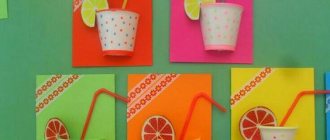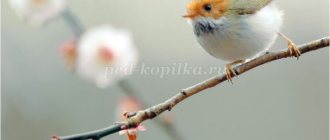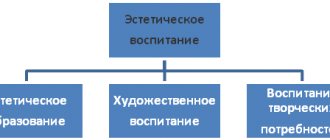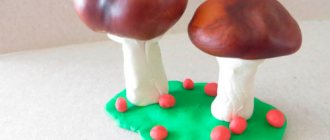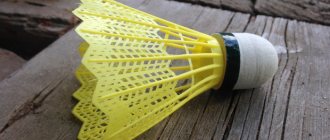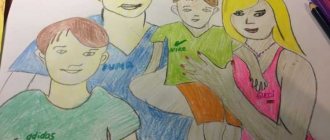Cognitive and sensory familiarity with the world around you
At this age it is especially interesting to hold everything in your hands and study materials. Drawing lessons for children should be treated as a game. Kids cannot be forced, they need to be given freedom and only slightly guided with the help of interesting tasks, while at the same time telling them something educational.
For example, we can devote one art lesson for children to studying the seasons and sketching autumn leaves or trees, and another time choose the topic of zoology and tell kids about tropical animals using appropriate plot compositions. It is also useful to draw simple geometric figures, which develops spatial thinking well and helps to better understand the structure of various objects.
A child’s tendency to understand the world around him, directed towards drawing, can bring enormous benefits to overall development: knowing about the existence of various textures, colors, shapes and their relationships, the child will be able to simultaneously develop logic, observation and the ability to analyze the environment.
Lesson notes on art
This section is devoted to the visual activities of preschoolers.
In the column on the left side there are links to ready-made notes for drawing classes, modeling classes, classes for designing from paper, natural materials and other types of art. activities. Some of the activities combine drawing, modeling, applique, speech development, familiarization with nature and the surrounding world. You can download any of the notes in one file. It should be remembered that quite a lot of classes in other categories also contain elements of visual activity (almost all complex classes and many of the classes in the “familiarization with nature” section - almost all classes for familiarization with plants and animals include modeling, drawing, appliqué, design made from natural material or paper), therefore, if you don’t find the activity you need here, you can look for it in other sections of our website. We hope that these notes will help you in working with children in kindergarten.
Modeling, drawing and any type of construction from paper or natural material are a powerful tool for influencing the development of children in the hands of a competent teacher. It is known that a child learns material best if he is interested in the object of study itself, and making drawing or modeling interesting is not so difficult. In addition to experience working with paints, plasticine or natural materials, children gain knowledge about the world around them and develop fine motor skills of their fingers, which has a beneficial effect on the development of speech. That is why art classes often become the basis for complex or integrated classes with elements of familiarization with nature, speech development and familiarization of children with the world around them.
In addition, drawing and other types of visual activities help develop children’s imagination and imagination, and also teach them to be neat, diligent and persevering. Well-designed stands with exhibitions of children's works delight parents of children and allow children to feel their importance.
If you notice any inaccuracies or omissions, please let us know. Also, if you have your own classes, then share them with others, write to us, send us the material and we will add to the number of notes.
Development of an open lesson on fine arts. (with presentation)
Development of an open lesson in fine arts.
Author of the development: Dorokhina Irina Grigorievna.
Lesson topic:
“Landscape - big world.”
The purpose of the lesson:
— expand students’ knowledge about landscape as a genre of fine art;
- introduce types of landscape genre; - to develop the ability to see beauty in the phenomena of the surrounding world; - create your own genre landscapes.
Tasks:
- develop new skills in working in various artistic techniques; — develop creative activity, imagination, memory, spatial thinking;
— to cultivate interest and respect for the work of domestic artists, incl. – local;
- instill love and respect for nature.
Planned results:
Subject:
- promote the development of aesthetic taste, artistic thinking, build logical justifications and reasoning; to train students in the use of various materials and means of artistic expression to convey the intent of their own activities.
Metasubject:
— learn to define a goal, participate in an educational dialogue, express one’s opinion, create oral texts to solve an educational task, plan an activity, work according to a plan, determine ways to achieve a goal, express one’s opinion, accept the position of classmates.
Personal:
- show interest in learning new material, cognitive activity, be aware of your emotions, and reasonably evaluate your own work and the work of your comrades.
Methods and forms of training:
conversation, explanatory-illustrative, practical; individual exhibition, frontal.
Equipment:
multimedia projector, computer presentation, chalkboard.
Introduction to the topic of the lesson:
“There is genuine joy in the charm of the Russian landscape, but it is not open to everyone and not even visible to every artist. In the morning, burdened with work, The labor of the forests, the cares of the fields, Nature looks, as if with reluctance, At us, not enchanted people...” This is how the poet N. Zabolotsky in the poem “Evening on the Oka” set the theme of our lesson.
So what are we going to study today? (landscape) What is landscape? (a genre of painting depicting nature, the landscape around us).
The landscape genre appeared in the 6th century in China, but was developed in the 17th century in Western Europe.
Nature is a book of wisdom, huge and vast, and this diversity has given rise to various types of landscape genre. I draw the children’s attention to a stand where various types of landscapes are presented. What will the topic of our lesson be called? (Landscape is a big world).
Students determine the purpose and objectives of the lesson using prompt questions.
Presentation for a fine arts lesson » Landscape - Bo PPTX / 15.71 Mb
/data/files/n1583484206.pptx (Presentation for the fine arts lesson “Landscape - Bo”) ( Main part.
Introduction to different types of landscape genre (correlate the name of the genre and the image presented on the board): - B. Yakovlev “Transport is getting better” - production, or industrial;
- F. Vasiliev “Wet meadow” - landscape, panoramic; - M. Saryan “Mountains” - mountain, panoramic; — V. Sibirsky “May 1, 1978” - urban, historical, heroic, panoramic;
— A. Kuindzhi “Evening in Ukraine” - rural; - I. Aivazovsky “Sea” - marine; — A. Plastov “Haymaking” - a panoramic landscape landscape combines with the everyday genre;
— I. Levitan “After the Rain” - river landscape.
The founder of the art gallery, Pavel Tretyakov, said: “I don’t need rich nature, no spectacular lighting, no miracles - give me at least a puddle of mud, so that there is nature and poetry in it, and poetry is the work of the artist.”
In our village of Khorol, there lived an artist who devoted his entire life to depicting the discreet beauty of his small Motherland. This is Dmitry Vasilyevich Vlasov. (The message and presentation were prepared by Varvara Morozova. (This message was prepared based on the results of the research work of students at our school.)
“Dmitry Vasilievich Vlasov was born near Voronezh in 1908. His father was a good painter and when the boy grew up, he began to help his father in his work. This is how the talent of the future artist was laid. In 1938, Dmitry Vasilyevich was drafted into the army and ended up serving in the Far East, in the seaside city of Suchan. Here he got married. In 1972, the family moved to Khorol. Dmitry Vasilyevich works in various organizations (in PMK-7, in the motorcade 1886) as an artist-designer, and in his free time he paints paintings to order. These were mainly landscapes depicting the coastal taiga around the Melgunovka River, waterfalls in the Chernigov region, and the coast of the Sea of Japan. The artist often included various animals in his landscapes - elk, deer, horses.
The artist died in 1999, leaving behind a rich cultural heritage - his paintings, which are in the regional museum of local history, in the houses of residents of the village of Khorol.”
Fizminutka
(doing an exercise for the eyes).
Practical part
. Creative work is performed in various groups, using various artistic techniques.
1 – individually (landscape in graphics);
2 – in pairs (collage, tamponing);
3 – groups (modeling and design: 1 group – model of a fantastic city; 2 group – a modern city by the sea; 3 group – model of a children’s town in the park). Thus, the guys perform different types of landscapes: rural, landscape, urban (fantastic, park and sea). The teacher reminds us of the importance of following the rules of composition in any landscape. The activities of schoolchildren are monitored and corrected during the completion of the task.
Final part.
The moment of “admiration”, the guys look and evaluate their work and the work of their comrades, express their opinions. Evaluation of work by the teacher. Homework.
Communication with peers
Our studio has opened a direction for the little ones - art classes for children 4-6 years old, the peculiarity of which is a combination of creative work and gameplay. Art with preschoolers can take place in an individual or group format. The development of the ability to communicate and communication skills occurs precisely at the age of 3.5-4 years. Therefore, it is very useful to bring your children to drawing courses, where they will learn the ability to communicate in a group, listen to others and express their thoughts. In the process of creating their creations, children communicate, observe each other, and see how different imagination and finished works can be.
Kids learn to accept different views of the world and recognize the existence of different opinions and views. This develops creativity and helps not to perceive the world stereotypically, expanding the child’s capabilities.
Responsibility and independence
Drawing lessons for children from 4 years old will also become lessons in independence. Your child will know that he has pencils, paints, paper and everything he needs for this activity. He will be able to consciously devote time to drawing, choose materials and accessories in accordance with the theme and style of the future drawing. In addition, having their own creative corner at home, children get used to tidying up the table and treating things with care.
Drawing lessons for preschool children are an excellent preparation for entering school. After developmental classes, it will be easier for children to cope with emotions, adapt to a team, and perceive new information. In addition, drawing is a good preparation for learning to write, training fingers and hand control. It also develops in children self-discipline, perseverance and the ability to bring what they start to completion.
You can ask questions and register your child for classes by calling 8 (391) 286-48-78 or on the website.
